High Pressure Switch (S4)
When the high pressure switch trips, the demand defrost control will cycle off the compressor, and the strike counter in the demand defrost control will count one strike. High Pressure (auto reset) − trip at 590 psig, reset at 418.
Low Pressure Switch (S87)
When the low pressure switch trips, the demand defrost control will cycle off the compressor, and the strike counter in the demand defrost control will count one strike. Low pressure switch (auto reset) − trip at 25 psig, reset at 40 psig.
The low pressure switch is ignored under the following conditions:
SDuring the defrost cycle and 90 seconds after the termination of defrost
SWhen the average ambient sensor temperature is below 15° F (−9°C)
SFor 90 seconds following the start up of the compressor
SDuring test mode
Ambient Sensor (RT13)
The ambient sensor considers outdoor temperatures below −35°F (−37°C) or above 120°F (48°C) as a fault. If the ambient sensor is detected as being open, shorted or out of the temperature range of the sensor, the demand defrost control will not perform demand defrost operation. The demand defrost control will revert to time/temperature defrost operation and will display the appropriate fault code. Heating and cooling operation will be allowed in this fault condition.
Coil Sensor (RT21)
Coil Sensor
outdoor temperatures below −35°F (−37°C) or above 120°F (48°C) as a fault. If the coil temperature sensor is detected as being open, shorted or out of the temperature range of the sensor, the demand defrost control will not perform demand or time/temperature defrost operation and will display the appropriate fault code. Heating and cooling operation will be allowed in this fault condition.
High Discharge Temperature Sensor (RT28)
If the discharge line temperature exceeds a temperature of 285°F (140°C) during compressor operation, the demand defrost control will de−energize the compressor contactor output (and the defrost output, if active). The compressor will remain off until the discharge temperature has dropped below 225°F (107°C) and the
1.If the demand defrost control recognizes five high discharge line temperature faults during a single (Y1) compressor demand, it reverts to a lockout mode and displays the appropriate code. This code detects shorted sensor or high discharge temperatures. Code on demand defrost control is Discharge Line Temperature Fault and Lockout.
2.If the demand defrost control recognizes five temperature sensor range faults during a single (Y1) compressor demand, it reverts to a lockout mode and displays the appropriate code. The demand defrost control detects open sensor or
The discharge line sensor, which covers a range of 150°F (65°C) to 350°F (176°C), is designed to mount on a ½" refrigerant discharge line.
NOTE − Within a single room thermostat demand, if 5−strikes occur, the demand defrost control will lockout the unit. demand defrost control 24 volt power R must be cycled OFF or the TEST pins on demand defrost control must be shorted between 1 to 2 seconds to reset the demand defrost control.
Crankcase Heater (HR1) and Crankcase Thermostat
Switch (S40)
The reference models are equipped with a 70 watt, belly band type crankcase heater. HR1 prevents liquid from accumulating in the compressor. HR1 is controlled by a thermostat located on the liquid line. When liquid line temperature drops below 50° F the thermostat closes energizing HR1. The thermostat will open, de−energizing HR1 once liquid line temperature reaches 70° F .
Liquid Line Bi−Flow Filter Drier
The unit is equipped with a large−capacity biflow filter drier which keeps the system clean and dry. If replacement is necessary, order another of like design and capacity. The replacement filter drier must be suitable for use with HFC−410A refrigerant.
The replacement filter drier must be suitable for use with HFC−410A refrigerant.
SECOND−STAGE OPERATION
If the demand defrost control (A108) receives a call for second−stage compressor operation Y2 in heating or cooling mode and the
If
The demand defrost control de−energizes the
Page 33
XP16 SERIES
